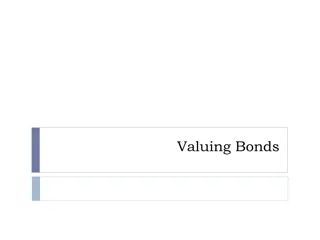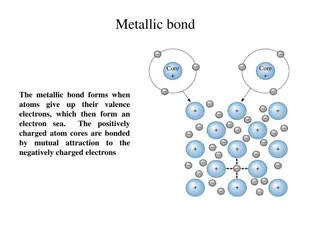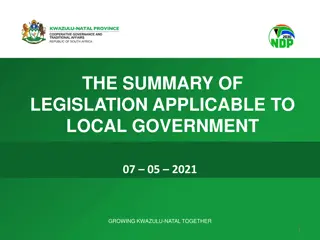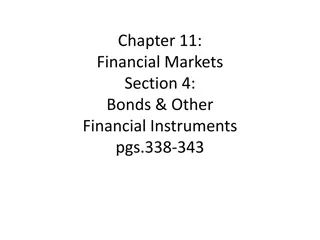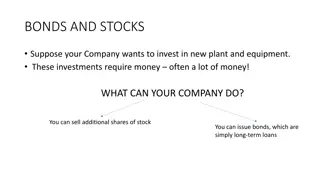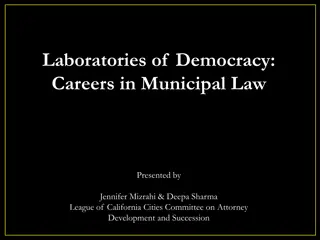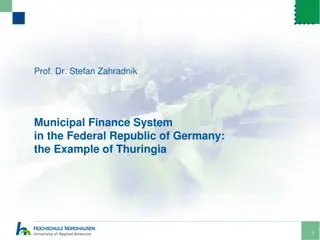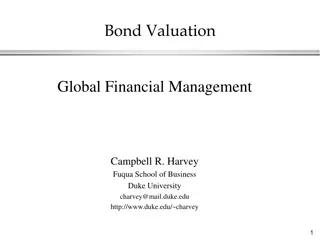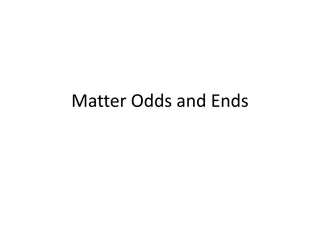Understanding Municipal Bonds in Public Finance
Explore the world of municipal bonds in public finance, essential for financing capital projects and spreading budgetary impacts over time. Learn how bonds are a burden-spreading tool, not a financing tool, and how they impact project funding decisions. Discover the real impacts of bonds, the volume of bonds in the market, and gain insights into general obligation bonds' significance in the municipal bond market.
Download Presentation

Please find below an Image/Link to download the presentation.
The content on the website is provided AS IS for your information and personal use only. It may not be sold, licensed, or shared on other websites without obtaining consent from the author. Download presentation by click this link. If you encounter any issues during the download, it is possible that the publisher has removed the file from their server.
E N D
Presentation Transcript
PUBLIC FINANCE SEMINAR PUBLIC FINANCE SEMINAR SPRING 2021, PROFESSOR YINGER SPRING 2021, PROFESSOR YINGER Municipal Bonds, 1 Municipal Bonds, 1
Bond Markets Bond Markets Class Outline Class Outline Overview Characteristics of Bonds Types of Bonds Bond Markets
Bond Markets Bond Markets Municipal Bonds Municipal Bonds Today s topic is state and local bonds, usually lumped together as municipal bonds municipal bonds. This is an important topic because financing capital projects without borrowing would cause huge short-run shocks to state and local tax rates. Borrowing allows a jurisdiction to spread the budgetary impact capital projects over time. spread the budgetary impact of large
Bond Markets Bond Markets Bonds and Taxes or Fees Bonds and Taxes or Fees Municipal bonds are not a financing tool, they are a burden-spreading tool. A government cannot finance capital spending with bonds; instead, it must finance this spending with taxes or fees and then spread the impact out over time impact out over time with bonds. spread the Decisions about bonds therefore are connected to decisions about the best way to finance a project, that is, about the most appropriate taxes and fees (based on equity and efficiency.)
Bond Markets Bond Markets The Real Impact of Bonds The Real Impact of Bonds Saying that bonds are a burden-spreading tool does not imply that they have no real impacts. In fact, there is a cost to spreading out the impact of a project over there is a cost to spreading out the impact of a project over time time, namely, interest costs, broadly defined. Poor bond Poor bond- -issuing policies can boost interest costs above the minimum issuing policies can boost interest costs above the minimum required level required level.
Bond Markets Bond Markets The Volume of Bonds The Volume of Bonds
Bond Markets Bond Markets Market Overview
Bond Markets Bond Markets Market Overview, 2 General obligation bonds make up about 1/4th of the muni market. Source: Bloomberg Barclays Municipal Bond Index, as of 8/2/2019. Other includes insured and pre-refunded bonds.
Bond Markets Bond Markets Overview of Bond Market Overview of Bond Market Tax-Exempt Bonds: A Description of State and Local Government Debt, Grant A. Driessen, Congressional Research Service, December 23, 2016 https://fas.org/sgp/crs/misc/RL30638.pdf Source of several figures in these slides.
Bond Markets Bond Markets What Is a Municipal Bond? What Is a Municipal Bond? A bond bond is a certificate of indebtedness certificate of indebtedness. The issuer return for the use of the purchaser s money over a given period of time. issuer agrees to pay interest to the purchaser purchaser in A bond contrasts with a stock, in which a firm exchanges part ownership in a company for the use of an investor s money. Stocks are not relevant for government.
Bond Markets Bond Markets Basic Bond Characteristics Basic Bond Characteristics Three key things are stamped on a bond: Face Value Face Value = = F F (= par value or redemption value or value at maturity). Coupon Rate Coupon Rate = = c c, which indicates the interest to be paid as a percentage of F and which can be either fixed or floating (i.e. tied to some other rate). Years to Maturity Years to Maturity = = N N, which is the number of years until the bond can be redeemed and is also the number of years during which the investor is entitled to collect interest.
Bond Markets Bond Markets Basic Bond Characteristics, 2 Basic Bond Characteristics, 2 Bonds are usually issued in serial some bonds have N=1, some have N=2, some have N=3, all the way up to the highest selected maturity, N*. This approach helps spread out the cost because it implies that only 1/N* of the bonds have to be paid back each year. serial form, which means that Bonds are usually issued with face values of $5,000 or multiples of $5,000. In the past, this meant that only large investors tended to buy them, but now anyone can invest any amount in bonds through a bond fund bond fund.
Bond Markets Bond Markets Basic Bond Characteristics, 3 Basic Bond Characteristics, 3 Other things that might be on a bond: Call Option Call Option, which gives the issuer the right to recall the bond before its maturity date (increasing the risk placed on the investor) Put Option Put Option, which allows the investor to redeem the bond before its maturity date (increasing the risk placed on the issuer) Insurance Insurance, against the possibility that the issuer cannot make the specified payments on time (lowering the risk placed on the investor, but imposing a cost on the issuer).
Bond Markets Bond Markets The Price of a Bond The Price of a Bond The first key to understanding bond markets is to think about the market price market price of a bond. This price equals the amount an investor would pay to purchase a bond. This market price is not the same thing as a bond s face value market price is not the same thing as a bond s face value!!
Bond Markets Bond Markets The Price of a Bond, 2 The Price of a Bond, 2 Suppose an investor has an alternative, similar investment, perhaps a U.S. Treasury Bill, that offers an interest rate r. Then r is the opportunity cost of investing in bonds, and the investor s willingness to pay is the present value of the benefits from holding the bond or cF + cF + cF + F = + + + + ... P (1 ) + r N N 2 (1 ) (1 ) (1 ) r r r
Bond Markets Bond Markets The Price of a Bond, 3 The Price of a Bond, 3 With the help of some algebra, this formula can be simplified to the following: 1 (1 + N ) r F = + P cF + N (1 ) r r + 1 (1 + N ) 1 r = F c + N (1 ) r r See the posted notes for details.
Bond Markets Bond Markets The Price of a Bond, 3 The Price of a Bond, 3 In the bond equation, all terms except the last are interest payments. The last term indicates the present value of the bond when it is redeemed. If P > F, the bond is said to sell at a premium premium; if P < F, the bond is said to sell at a discount discount.
Bond Markets Bond Markets The Price of a Bond, Tangent The Price of a Bond, Tangent The first part of this formula is equivalent to a mortgage equal to $P with a payment each period of cF, or r + ( ) = Payment Mortgage Amt 1 (1 N ) r where N is the length of the mortgage and r is its interest rate. The obvious difference between bonds and mortgages is that a mortgage cannot be redeemed at the end.
Bond Markets Bond Markets A Bond s Rate of Return A Bond s Rate of Return The second key to understanding bond markets is to think about the rate of return rate of return on a bond that sells at price P. This rate of return is the value of r at which the above equation is true, given P. This is a standard type of present-value calculation; it is often called finding the internal rate of return internal rate of return. In the case of bonds, it is called calculating a bond s yield to maturity to maturity. yield
Bond Markets Bond Markets Calculating Yield to Maturity Calculating Yield to Maturity Calculating the yield to maturity is difficult because the equation is nonlinear. But spreadsheet programs are set up to do this type of calculation, that is, to find an internal rate of return (IRR).
Bond Markets Bond Markets Price and Rate of Return Price and Rate of Return The difference between these two ways of looking at bonds corresponds to what is unknown. In the first case r is known, but P is not. We use the present-value equation to solve for P. In the second case, P is known, but r is not. We use the present-value equation to solve for r.
Bond Markets Bond Markets Types of Bonds Types of Bonds Bonds come in many different types, including the following: Zero Coupon Bond Zero Coupon Bond = a bond that pays no interest. This bond obviously must sell at a huge discount because all of its return comes in the form of a capital gain. Compound Interest Bond Compound Interest Bond = Capital Appreciation Bond bond that puts interest payments in an account and lets them accumulate but does not pay them out until the maturity date. This bond changes the time pattern of payments by saving all the interest until the end. Capital Appreciation Bond = a
Bond Markets Bond Markets Types of Bonds, 3 Types of Bonds, 3 The prices of these types of bonds can be obtained with some algebra: F = Zero-coupon bond: P + )N (1 r ( ) + + N (1 + ) 1 F F c + + N (1 (1 ) ) c r = = Capital Appreciation Bond: P F N N (1 ) r
Bond Markets Bond Markets Types of Bonds, 4 Types of Bonds, 4 Some budget officials like these 2 types of bonds because they push the re-payment streams into the future. These bonds do not save money, however, because they do not change the present value of the re-payment stream. The following table gives an example. Zero-coupon bonds are generally avoided near a borrowing limit because they have the highest face values.
Bond Markets Bond Markets Types of Bonds, 5 Types of Bonds, 5 Table 1. Payments on Three Types of Municipal Bond Table 1. Payments on Three Types of Municipal Bond Standard Zero-Coupon Capital Appreciation Year Year Actual $7,500.00 $7,250.00 $7,000.00 $6,750.00 $6,500.00 $6,250.00 Present Value $7,142.86 $6,575.96 $6,046.86 $5,553.24 $5,092.92 $4,663.85 Actual $6,475.23 $6,475.23 $6,475.23 $6,475.23 $6,475.23 $6,475.23 Present Value $6,166.88 $5,873.22 $5,593.55 $5,327.19 $5,073.51 $4,831.92 Actual $5,250.00 $5,512.50 $5,788.13 $6,077.53 $6,381.41 $6,700.48 Present Value $5,000.00 $5,000.00 $5,000.00 $5,000.00 $5,000.00 $5,000.00 1 1 2 2 3 3 4 4 5 5 6 6 7 7 8 8 9 9 10 10 $6,000.00 $5,750.00 $5,500.00 $5,250.00 $4,264.09 $3,891.83 $3,545.35 $3,223.04 $6,475.23 $6,475.23 $6,475.23 $6,475.23 $4,601.82 $4,382.69 $4,173.99 $3,975.23 $7,035.50 $7,387.28 $7,756.64 $8,144.47 $5,000.00 $5,000.00 $5,000.00 $5,000.00 $63,750.0 $64,752.2 Total Total 0 $50,000.00 9 $50,000.00 $66,033.94 $50,000.00 Note: The coupon rate and opportunity cost are set at 5%. The table presents the Note: The coupon rate and opportunity cost are set at 5%. The table presents the total payments on bonds of all maturities in each year. The face values of the total payments on bonds of all maturities in each year. The face values of the standard and capital appreciation bonds are $5,000; the face values of the zero standard and capital appreciation bonds are $5,000; the face values of the zero- - coupon bonds are $6,475.23. The standard and capital appreciation bonds sell for coupon bonds are $6,475.23. The standard and capital appreciation bonds sell for $5,000, whereas the zero $5,000, whereas the zero- -coupon bonds sell for amounts between $4,761.91 (1 coupon bonds sell for amounts between $4,761.91 (1- -year maturity) and $3,069.57 (10 maturity) and $3,069.57 (10- -year maturity). year maturity). year
Bond Markets Bond Markets Types of Bonds, 6 Types of Bonds, 6 Perpetuity Perpetuity = a bond with N= , so it just pays interest and never gets to the redemption date. Perpetuities aren t used often because they put a perpetual burden on government. But they are interesting to evaluate. With an infinite N, the present-value formula simplifies to: P = cF r So if c = r, then P = F; if c< r, the bond sells at a discount (P < F); and if c > r, the bond sells at a premium. Discounts and premiums can arise even if a bond never matures!
Bond Markets Bond Markets Categories of Municipal Bond Categories of Municipal Bond Bonds backed by full taxing authority of issuing government General Obligation Bonds (GO) Moral Obligation Bonds Double Barreled GO Bonds Bonds backed by Specific Revenue Source Revenue Bond Agency Bond Tax Increment Bond
Bond Markets Bond Markets Categories of Municipal Bond, 2 ( Categories of Municipal Bond, 2 (Driessen Driessen) )
Bond Markets Bond Markets Categories of Municipal Bond, 2 Categories of Municipal Bond, 2 Bonds backed by private revenue source Industrial Development Bonds Pollution Control Bonds Mortgage Revenue Bonds Bonds to Smooth Timing Problems Tax Anticipation Notes (TANs) Revenue Anticipation Notes (RANs) Bond Anticipation Notes (BANs)
Bond Markets Bond Markets Investments that Compete with Bonds Investments that Compete with Bonds Governments must compete for investor s funds with many other types of investment, including: Stocks Corporate Bonds Federal Bonds (Savings bonds, treasury bonds, agency bonds) Mortgages
Bond Markets Bond Markets The Market for The Market for Tax- -Exempt Loanable Funds Exempt Loanable Funds Tax Demand Demand: State and local governments want loanable funds to smooth revenue flows Supply Supply: Investors with high marginal tax rates prefer tax-exempt investments, such as munis, for reasons explored later.
Bond Markets Bond Markets The Market for Municipal Bonds The Market for Municipal Bonds i i = interest = interest rate rate = yield to = yield to maturity maturity S = Lending S = Lending D = Borrowing D = Borrowing $s of Loanable Funds $s of Loanable Funds
Bond Markets Bond Markets The Market for Municipal Bonds, 2 The Market for Municipal Bonds, 2 P P = Price = Price of a Bond Bond S = Borrowing S = Borrowing of a D = Lending D = Lending Number of Bonds Number of Bonds
Bond Markets Bond Markets Impact of Tight Monetary Policy Impact of Tight Monetary Policy (or loss of confidence in munis or new tax-exempt savings options) The Market for Municipal Bonds The Market for Municipal Bonds S S2 2 i i S S1 1 = Lending = Lending i2 i1 D = Borrowing D = Borrowing $s of Loanable Funds $s of Loanable Funds
Bond Markets Bond Markets Initial Impact of Initial Impact of Industrial Development Bonds Industrial Development Bonds (or Mortgage Revenue Bonds) The Market for Municipal Bonds The Market for Municipal Bonds S = Lending S = Lending i i i2 i1 D D2 2 D D1 1 = Borrowing = Borrowing $s of Loanable Funds $s of Loanable Funds


